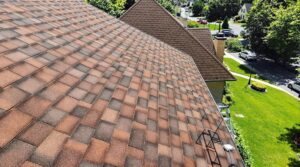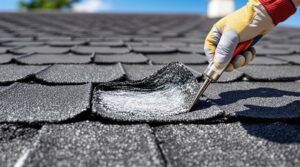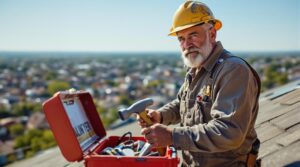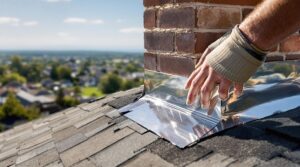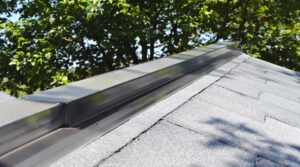Is your roof trying to tell you something? Let's decode whether it needs a quick fix or a complete makeover!
Think of your roof like a protective helmet – when it's slightly scratched, a repair might do, but if it's cracked all over, you'll want a new one. Minor battle scars like a few missing shingles or a sneaky leak can often be patched up for anywhere between $150 to $1,000, saving you from a bigger headache down the road.
But when your roof starts showing its age with widespread wear, curling shingles, or multiple leaks, it's time to consider a full replacement. Just like upgrading your smartphone, a new roof is an investment – typically ranging from $7,000 to $50,000 depending on your home's size and material choices.
Not sure which path to take? Today’s roofing pros use cool tech like moisture-detecting gadgets and drone inspections to get the full picture of what’s happening up there. And here’s a pro tip: if you’re dealing with insurance, working with a public adjuster could be your secret weapon. They’re like roof-claim whisperers, often helping homeowners secure substantially better settlements for the right solution. Additionally, understanding how to file an insurance claim can be daunting, but with the right guidance, it becomes much more manageable. A public adjuster can simplify this process, ensuring that you have all the necessary documentation and evidence to support your claim. By leveraging their expertise, you not only save time but also increase your chances of receiving a fair compensation for your roofing needs.
Remember, your home's crown deserves royal treatment – whether it needs a simple touch-up or a complete coronation!
Key Takeaways
"Is your roof crying out for help? Let's decode whether it needs a band-aid or a complete makeover!
Think of your roof like a protective helmet – while a small crack might need a quick fix, multiple damage points signal it's time for a fresh start. A simple repair job typically runs $150-$1,000, perfect for those isolated trouble spots. But when your roof's showing multiple battle scars, a full replacement ($7,000-$50,000) might be your best bet.
Your attic’s telling stories – notice sunlight sneaking through the boards? That’s your roof’s way of waving a red flag for replacement. On the flip side, if you’re just dealing with a few rebellious shingles, a repair could be your wallet’s best friend. Before you dive into a repair or replacement, it’s crucial to weigh your options carefully. Repairing roof shingles considerations include the age of your roof, the extent of the damage, and your long-term plans for your home. A patch job may suffice for minor issues, but if your roof’s starting to show its age, investing in a full replacement could save you from costlier headaches down the line.
Here's the real tea: age matters! Just like your smartphone, roofs have a lifespan. Throwing money at constant repairs on an aging roof is like putting premium gas in a clunker – sometimes starting fresh makes more sense.
Want to boost your home's value while shrinking those energy bills? A full replacement's got your back. But if you're in a pinch and the damage is minimal, a quick repair can keep you covered (literally!).
Pro tip: Got insurance? Working with a public adjuster is like having a roof-savvy negotiator in your corner. They often unlock better settlements, making that full replacement more achievable than you might think."
Understanding the Key Differences Between Roof Repair and Replacement
The distinction between roof repair and replacement represents a critical decision point for property owners facing roofing issues. Evaluating the extent of the damage and the long-term implications of each option is essential. Many homeowners often find themselves asking, “is roof replacement a repair,” as they weigh the costs and benefits. Understanding the various factors involved, such as the age of the roof, the materials used, and the specific issues at hand, can guide them toward making an informed choice that best suits their needs.
Roof repair focuses on addressing isolated damage or specific problems while maintaining the existing structure, utilizing targeted repair techniques to extend the current roof's functionality.
In contrast, replacement involves complete removal and installation of new roofing materials, addressing underlying structural concerns.
The roof lifespan considerably influences this decision-making process.
While repairs can effectively manage minor issues like missing shingles or isolated leaks, replacement becomes necessary when the roof has reached the end of its serviceable life or exhibits extensive deterioration.
Understanding these fundamental differences enables property owners to make informed decisions that balance immediate needs with long-term structural integrity and cost-effectiveness.
Proper damage documentation through detailed photos and receipts is essential for insurance claims whether pursuing repairs or full replacement.
Signs That Help You Choose Between Repair or Replacement
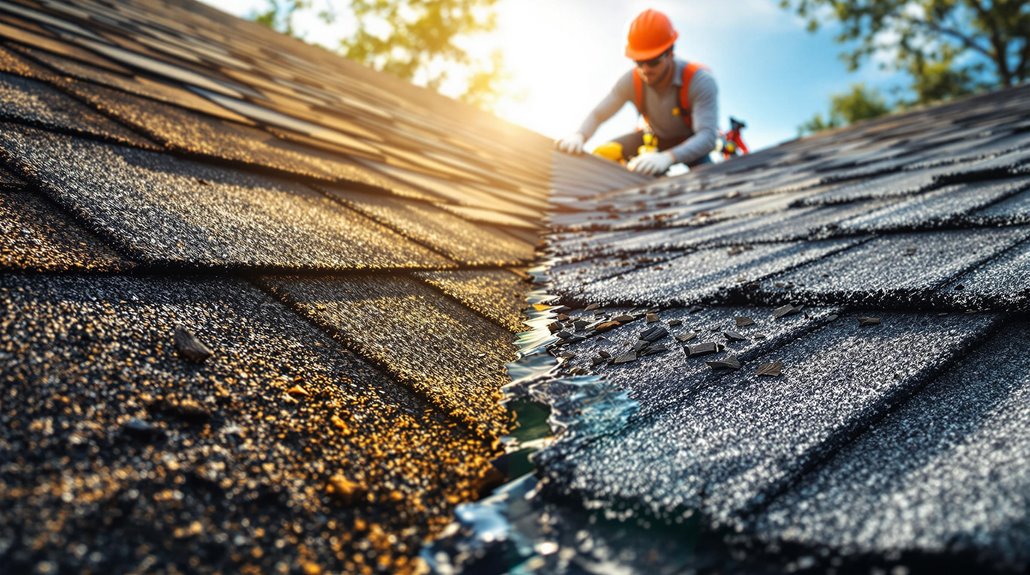
Identifying specific indicators enables property owners to make informed decisions between roof repair and replacement options. Several key factors determine the appropriate course of action, including visible structural issues, extent of damage, and roof lifespan considerations.
When daylight penetrates through attic boards or multiple shingles exhibit warping and curling from weather impacts, replacement typically becomes necessary. Conversely, isolated issues like minor shingle damage or limited leaks often warrant repairs.
Professional assessment remains essential in evaluating material condition, structural integrity, and cost-effectiveness of each option. The age of existing roofing materials, frequency of repairs, and presence of widespread damage serve as critical determinants.
Property owners must also consider long-term factors such as energy efficiency improvements, warranty coverage, and the potential impact on property value when choosing between repair and replacement solutions.
Insurance claims involving public adjuster services can increase settlement amounts by 20-50% when evaluating repair versus replacement options.
Cost Analysis: Comparing Your Roofing Options
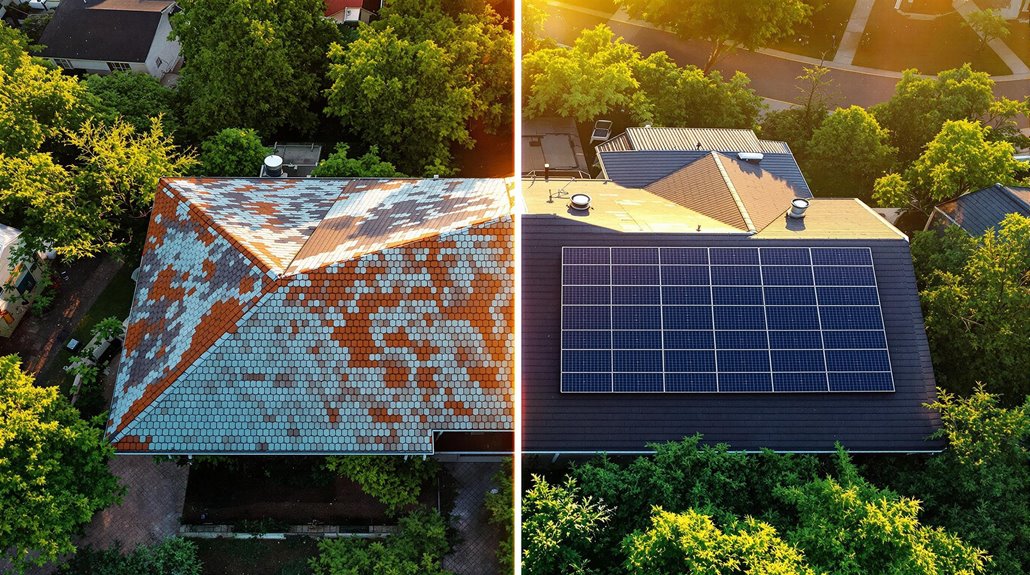
Analyzing the financial implications of roofing decisions requires careful consideration of both immediate costs and long-term investments. Minor repairs typically range from $150 to $1,000, while extensive repairs can exceed $3,000. Full roof replacement, depending on materials and scope, ranges from $7,000 to $50,000. Understanding the various options available is crucial in making informed decisions. With many roofing systems enduring varying lifespans and efficiency levels, homeowners must weigh the initial expenses against potential savings on future repairs and energy bills. For those looking for guidance, resources like ‘roof repair types explained‘ can provide valuable insights into the most suitable choices for their specific needs. Additionally, exploring the different roof installation material types is essential for homeowners to ensure they choose the most suitable option for their climate and budget. Each material comes with its own set of advantages and drawbacks, impacting not only the upfront cost but also the roof’s durability and maintenance needs over time. By researching these factors, homeowners can make a more strategic decision that balances their financial outlay with long-term benefits. Additionally, homeowners should be aware of how home insurance and roof replacement costs can interact, as certain policies may cover partial or full replacement under specific circumstances. This connection highlights the importance of reviewing insurance coverage before making significant roofing investments. Ultimately, careful planning and understanding of one’s financial situation can lead to better choices that safeguard both the home and budget over time. Additionally, homeowners should consider factors such as warranties and the resale value of their property when assessing roofing options. A thorough roof repair and replacement comparison can help highlight which investment not only meets immediate needs but also enhances long-term property value. Engaging with professionals to evaluate these aspects can lead to more strategic choices that align with both budget constraints and future financial goals.
When evaluating repair longevity against replacement options, several factors influence cost-effectiveness:
- Repair frequency and cumulative expenses over time
- Energy efficiency improvements through thorough replacement
- Property value enhancement from new roofing installation
- Warranty coverage and long-term protection benefits
The age and condition of existing roofing materials greatly impact the financial equation. While repairs may seem cost-effective initially, successive repairs on aging roofs often exceed the long-term value of a complete replacement, particularly when considering energy savings and structural integrity. Working with public adjusters can increase insurance claim settlements by up to 350% for roof replacement projects. Moreover, understanding the specifics of roof wind damage repairs explained can further aid homeowners in decision-making when assessing their roofing options. By documenting existing damage and working alongside professionals, homeowners can ensure they are adequately compensated for the repairs needed. This comprehensive approach not only streamlines the claims process but also emphasizes the importance of investing in a durable, long-lasting roofing solution. Additionally, homeowners should familiarize themselves with the roof hail damage repairs overview, which outlines the specific types of damage covered by insurance and the best practices for filing claims. By being proactive and informed, they can navigate the complexities of insurance policies and maximize their potential settlements. Ultimately, a strategic approach to roofing and insurance claims not only reinforces the structural integrity of their homes but also enhances long-term financial savings and peace of mind. Homeowners should also be vigilant in identifying hurricane roof damage signs, as early detection can prevent more extensive and costly repairs down the line. Regular inspections, especially after severe weather events, can help catch subtle signs of damage that might otherwise go unnoticed. By being proactive and informed, homeowners can make better choices for their roofing needs, ensuring both safety and financial prudence in the long run. Homeowners should also be vigilant in recognizing storm damage roof replacement signs, such as water stains on ceilings, missing shingles, or granules accumulating in gutters. Identifying these issues early can prevent more extensive and costly repairs down the line, allowing for timely interventions. Ultimately, prioritizing a proactive approach to roofing maintenance and damage assessment can save homeowners significant amounts in the long run while enhancing the overall safety and efficiency of their homes. Recognizing hurricane roof damage signs early can significantly mitigate overall repair costs and prevent further deterioration. Homeowners should be vigilant in inspecting their roofs after severe weather events, as timely interventions can lead to more manageable repairs or a productive insurance claim process. Ultimately, being proactive about roof maintenance and understanding the nuances of insurance claims will empower homeowners to make informed choices that enhance their property’s longevity and value. Furthermore, homeowners should prioritize negotiating roof replacement claims effectively to maximize their potential settlements. This negotiation process involves presenting thorough documentation and clear evidence of damage, which can significantly influence the insurance adjuster’s assessment. Ultimately, by taking a proactive approach in dealing with insurance companies, homeowners can secure better financial outcomes and invest more confidently in high-quality roofing systems that will stand the test of time.
Making the Smart Choice for Your Home and Budget
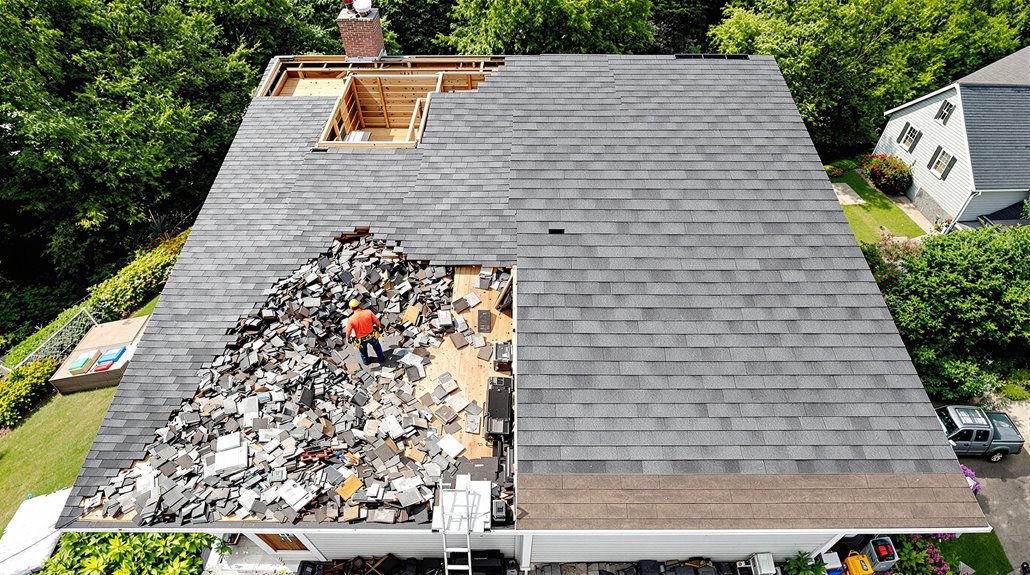
When faced with roofing decisions, homeowners must systematically evaluate multiple factors to determine whether repair or replacement represents the most prudent investment. Critical considerations include evaluating the roof lifespan, extent of damage, and long-term financial implications through strategic budget planning.
A thorough decision matrix should incorporate both immediate and future variables. Structural integrity, frequency of past repairs, and the presence of widespread versus localized damage serve as key determinants.
Additionally, homeowners must weigh the temporary nature of repairs against the substantial benefits of full replacement, including enhanced energy efficiency and increased property value.
Insurance coverage, material availability, and professional evaluations from qualified contractors further inform this critical residential infrastructure decision, ensuring efficient resource allocation while maintaining building integrity.
With typical roofs depreciating by 4% each year, homeowners should carefully consider their current roof age when evaluating repair versus replacement options. Homeowners should also take into account the materials used and the roof’s overall condition, as these factors can significantly impact its lifespan and performance. Additionally, understanding age considerations for roof insurance is crucial, as many policies have specific clauses regarding roof age and replacement coverage. By evaluating these aspects, homeowners can make informed decisions that protect their investment and ensure their home remains safe and secure.
Long-Term Benefits and Return on Investment
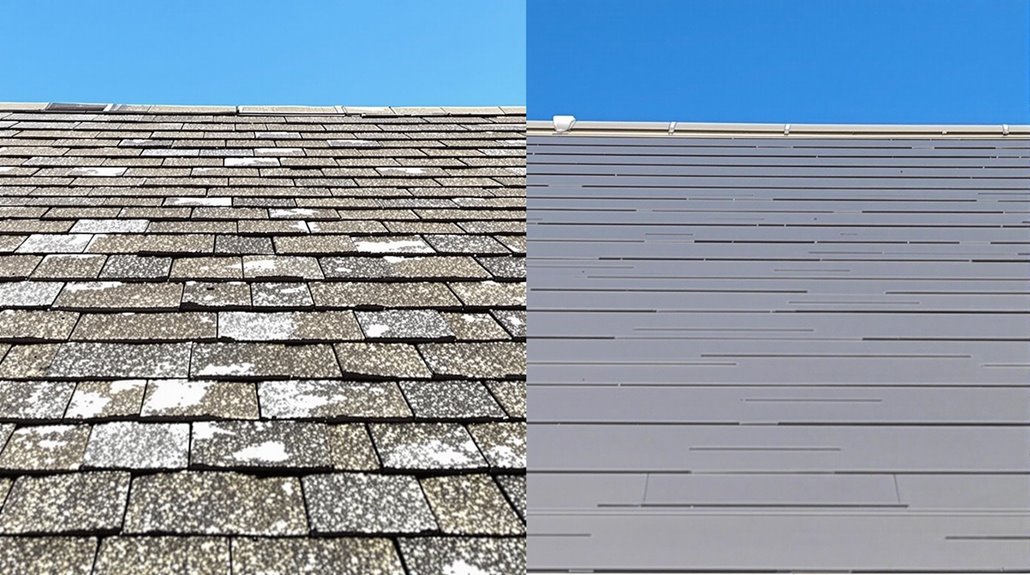
The long-term financial implications of roof replacement extend far beyond initial expenditures, encompassing multiple variables that impact overall return on investment. While upfront costs may appear substantial, the long-term savings potential through enhanced energy efficiency and reduced maintenance requirements often justifies the investment.
Key factors contributing to positive ROI include:
- Decreased energy consumption through improved insulation and modern materials
- Elimination of recurring repair expenses associated with aging roofs
- Enhanced property value through structural integrity improvements
- Reduced maintenance costs due to superior material durability
High-performance roofing materials, though initially more expensive, typically deliver superior long-term value through extended lifespans and improved weather resistance.
The combination of energy efficiency benefits, reduced maintenance requirements, and increased property value creates a compelling financial case for roof replacement over continuous repairs.
Professional installation by certified roofers helps prevent future leak issues and ensures proper structural assessment for maximum longevity.
The Benefits Of Consulting A Public Adjuster
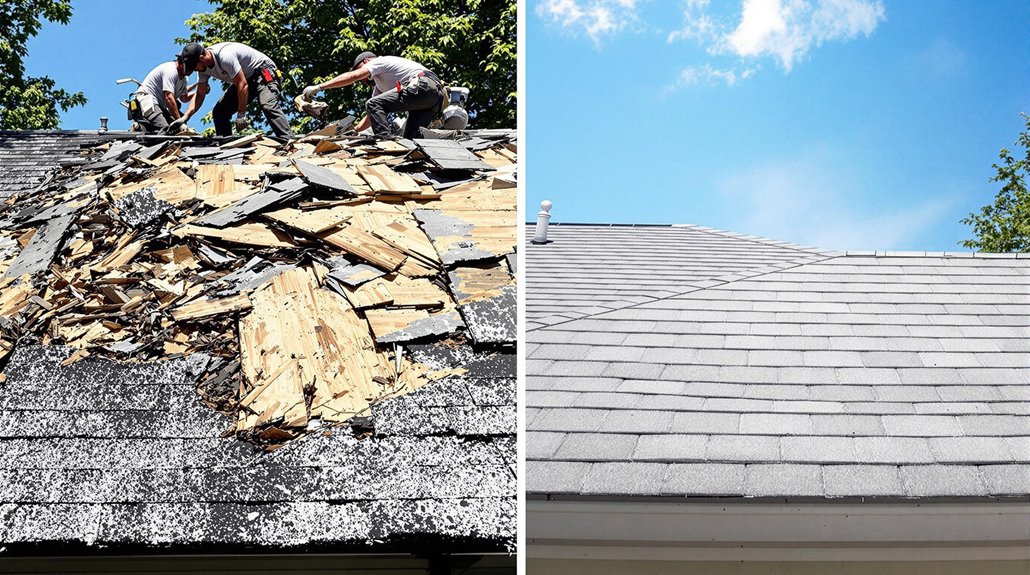
Public adjusters provide invaluable expertise in maneuvering complex insurance claims through objective damage assessments and thorough policy interpretation.
Their professional representation streamlines the claims process by managing documentation, evidence collection, and negotiations with insurance carriers.
Statistical data indicates that policyholders who engage public adjusters typically secure higher settlement amounts compared to those who process claims independently.
Claims assisted by public adjusters show 800% higher settlements compared to independently filed insurance claims.
Expertise In Insurance Claims
Maneuvering complex insurance claims for roof damage requires specialized expertise that professional public adjusters provide through their thorough understanding of policies, procedures, and negotiation strategies. These experts not only facilitate effective communication between the insured and the insurance company but also ensure that clients are aware of their rights and obligations throughout the claims process. Additionally, they often share valuable roof repair and replacement tips to help homeowners make informed decisions that can minimize further damage and costs. By leveraging their experience, public adjusters aim to maximize the settlement amount, ensuring that the insured can restore their property to its original condition. Moreover, roofing public adjusters explained the intricate details of policy language, helping clients navigate through the various coverage options available to them. They are also skilled in documenting damage thoroughly, which is crucial for substantiating claims and preventing potential disputes with the insurer. Ultimately, their goal is to alleviate the stress associated with the claims process, allowing homeowners to focus on the restoration of their homes.
Their extensive knowledge of policyholder rights and insurance claim strategies guarantees ideal outcomes for property owners facing roofing issues.
Public adjusters leverage their expertise through:
- Detailed policy interpretation and analysis of coverage parameters
- Strategic documentation compilation, including damage assessments and repair estimates
- Professional negotiation with insurance carriers to maximize settlement values
- Efficient management of claims procedures while maintaining compliance with regulations
Their technical proficiency in policy interpretation, combined with their understanding of insurance law, enables them to navigate intricate claim processes effectively while advocating for the policyholder's interests throughout the settlement process.
Studies show that working with public adjuster representation can increase settlement amounts by 20% to 50% compared to self-managed insurance claims.
Objective Damage Assessment
When property owners seek accurate evaluations of roof damage, consulting a public adjuster provides essential benefits through systematic, unbiased assessments that maximize claim potential.
Their specialized knowledge enables precise damage evaluation using advanced tools like moisture meters and drones, ensuring thorough documentation of both visible and hidden issues.
Public adjusters deliver enhanced claim accuracy through detailed photographic evidence, thorough reports, and expert cost estimations.
Their unbiased approach focuses on identifying all damages, from structural concerns to subtle defects, without influence from insurance company interests.
This specialized expertise proves particularly valuable in complex situations, where distinguishing between cosmetic and structural damage requires technical proficiency.
Their methodical assessment process incorporates objective data collection and professional documentation techniques, establishing a robust foundation for successful claim negotiations.
Licensed professionals must maintain independence from both insurance companies and roofing contractors to provide truly objective assessments.
Streamlined Claim Process
The complex process of filing an insurance claim becomes considerably more efficient through the strategic involvement of a public adjuster. Their professional expertise facilitates streamlined communication between all parties while ensuring thorough documentation of damages.
Public adjusters implement systematic approaches to expedite claim resolutions through their specialized knowledge of insurance policies and procedures.
Research demonstrates that claims handled by public adjusters result in 800% higher settlements compared to those filed without professional representation.
Key advantages of utilizing a public adjuster include:
- Expedited claim processing through proactive insurance company engagement
- Reduced administrative complexity via professional document management
- Enhanced claim validity through efficient documentation and detailed damage reports
- Optimized outcomes through expert policy interpretation and strategic negotiation
This systematic approach minimizes potential delays, reduces claim denials, and maximizes the probability of favorable settlements while alleviating the burden on property owners throughout the claims process.
Higher Claim Payouts & Settlements
Professional engagement with a public adjuster delivers substantial increases in insurance claim settlements through strategic policy interpretation and expert negotiation tactics.
Case studies demonstrate settlement increases of up to 50% when public adjusters implement effective claim strategies, ensuring thorough damage assessment and accurate documentation.
Their technical expertise enables identification of overlooked damage while maximizing payout negotiation through thorough understanding of policy terms and coverage limits.
Public adjusters leverage insider knowledge of insurance industry practices to counter minimization tactics, securing settlements that reflect true replacement costs.
Their systematic approach to documentation, combined with strategic advocacy, results in expedited claim resolution and ideal compensation.
This expertise proves particularly valuable in complex roofing claims where proper assessment and documentation greatly impact settlement outcomes.
Research shows that public adjuster involvement typically results in settlements 10-15% higher compared to claims filed without professional representation.
About The Public Claims Adjusters Network (PCAN)

Licensed public claims adjusters within PCAN form an extensive network of independent professionals dedicated to advocating for policyholders during insurance claims processes. Their expertise in policyholder advocacy and claims negotiation guarantees optimal results for insurance settlements.
These specialists operate autonomously from insurance carriers, focusing exclusively on protecting clients' interests.
Key functions of PCAN adjusters include:
- Analysis and interpretation of complex insurance policy documentation
- Thorough damage assessment and value determination
- Strategic negotiation with insurance providers for maximum settlement
- Professional management of claim documentation and submission processes
PCAN members maintain professional certifications, including SPPA designations, and undergo continuous education to stay current with industry regulations and best practices.
Their specialized knowledge enables efficient navigation of intricate claims procedures while maximizing settlement potential for policyholders.
Frequently Asked Questions
How Long Does a Typical Roof Replacement Take to Complete?
Typical roof replacement timeline expectations range from one to five days, contingent upon material selection, roof size, and potential project disruptions, with residential installations generally completing within one to three days.
Can I Stay in My Home During a Roof Replacement?
While noise concerns and falling debris exist, homeowners can safely remain in their residence during roof replacement when proper safety precautions are implemented, though temporary relocation during work hours may increase comfort.
What Happens if It Rains During My Roof Repair?
Rain during roof repairs poses significant risks, including potential water damage to interior structures and compromised repair safety. Contractors typically halt work and implement protective measures until conditions improve.
Are There Eco-Friendly Roofing Materials Available for Replacements?
Modern roofing innovations offer numerous sustainable options, including cool roofs, recycled metal materials, solar panels, clay tiles, and synthetic shake shingles, all providing enhanced energy efficiency and reduced environmental impact.
Do I Need Permits for Roof Repairs or Replacements?
Like a blueprint for success, permit requirements are mandatory for roofing projects exceeding 500 square feet, structural modifications, and material changes, according to local roofing regulations and building codes.
References
- https://roofclaim.com/repair-or-replace-your-roof/
- https://www.angi.com/articles/how-much-do-roof-repairs-cost.htm
- https://colonyroofers.com/learningcenter/roof-repair-vs-roof-replacement
- https://www.nationsroof.com/roof-restoration-vs-replacement/
- https://monarchroofing.biz/roof-repair-cost/
- https://roofsimple.com/roof-repair-vs-replacement/
- https://www.rainvillecarlson.com/roof-repair-vs-replacement-whats-best/
- https://staydryroofing.com/top-differences-between-a-reroof-vs-roof-replacement/
- https://www.fbfs.com/learning-center/signs-you-may-need-to-repair-or-replace-your-roof
- https://www.gougequalityroofing.com/blog/roof-repair-vs-roof-replacement-heres-how-to-know/


